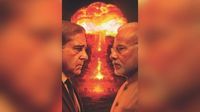In the simmering heat of May 2025, South Asia once again found itself teetering on the edge of disaster. The world watched with bated breath as India and Pakistan, two nuclear-armed neighbors with a history of bitter conflict, exchanged blows in a brief but intense four-day war that threatened to spiral into a catastrophe of unimaginable proportions. The aftermath has left both countries trading accusations, raising the specter of nuclear war, and fueling anxieties about the region’s future stability.
The immediate spark for the conflict was a deadly terror attack in Pahalgam, Indian-administered Kashmir, in April 2025, which killed 26 civilians. Citing Pakistan’s alleged support for terrorist groups, India launched precision strikes on May 7, targeting camps across the border but deliberately avoiding military installations. Indian officials, according to India Today, hoped this would serve as a strong deterrent and avoid further escalation—unless, they warned, Pakistan retaliated.
But Pakistan wasn’t about to let the strikes go unanswered. Over the next three days, the fighting intensified dramatically. Both sides unleashed their air forces, missiles, and increasingly sophisticated drones. According to India Today, Indian officials claimed their superior firepower gave them the upper hand, ultimately forcing Pakistan to seek a ceasefire. However, the reality was far more complex, with the fog of war clouding both narratives and outcomes.
Behind the scenes, international actors scrambled to douse the flames. It was U.S. President Donald Trump who, in a characteristically brash social media post, declared that the United States had brokered the ceasefire, even before either combatant could make the announcement themselves. Trump’s later remarks at a White House briefing were even more dramatic: “We stopped a nuclear conflict. I think it could have been a bad nuclear war. Millions of people could have been killed.”
This assertion was met with skepticism in New Delhi. Indian Prime Minister Narendra Modi, in a national address on May 12, insisted that India’s Operation Sindoor had proved the country “would not be deterred by nuclear blackmail.” Foreign Secretary Vikram Misri flatly denied any “nuclear signalling” during the war, while American officials, including Vice President J.D. Vance, described a high-stakes diplomatic scramble to prevent further escalation.
Yet, as India Today reported, the most perilous hours came in the early morning of May 10. Retaliatory Pakistani strikes—codenamed Operation Bunyan Marsoos—targeted 26 sensitive Indian locations, including an attempted Fatah-II missile attack on Delhi airport, intercepted by Indian missile defense. India’s counterattack was swift and ferocious, with BrahMos hypersonic cruise missiles hitting eight Pakistani air bases, including Nur Khan near Islamabad, which lies close to Pakistan’s nuclear command center. For eight tense hours, from 2:30 am to 10:30 am, the subcontinent hung in the balance.
Brigadier Feroz Hassan Khan, a former officer in Pakistan’s Strategic Plans Division, told India Today, “The fact that Nur Khan was hit [near] the capital city would create more political pressure. Both India and Pakistan had climbed the rungs of the military escalation ladder so fast, it was evident that in the next 24-48 hours, the tipping point would have been reached for an all-out war.” He added, “Had India inadvertently hit a nuclear storage site, Pakistan would have considered it as a first strike and retaliated with nuclear weapons. If the ceasefire had not been called on May 10, the next night would have been a terrible one.”
Fortunately, a ceasefire was agreed upon before the worst could happen. According to American and Indian officials, the truce came about through a mix of military pressure and diplomatic inducements. U.S. Secretary of State Marco Rubio played a key role, urging both sides to de-escalate and offering assistance in starting talks to avoid future conflicts. A readout from the U.S. State Department emphasized the need for both countries to “identify methods to de-escalate and re-establish communication to avoid miscalculation.”
The nuclear dimension of the crisis was never far from anyone’s mind. Since their nuclear tests in 1998, both India and Pakistan have significantly expanded their arsenals. India adheres to a no-first-use doctrine, pledging not to use nuclear weapons unless first attacked. Pakistan, in contrast, reserves the right to use nuclear weapons first if its territorial integrity or economy is threatened. Over the past decade, Pakistan has added tactical nuclear weapons and battlefield missiles, introducing a dangerous “hair-trigger” complexity to its command and control systems. As Ashley Tellis, a leading expert on South Asian nuclear strategy, observed in India Today, “Pakistan is increasingly driven less by what India is actually doing and more by its fervid imaginings of India’s capabilities coupled with an expansive—and expanding—notion of what its nuclear requirements entail.”
This wasn’t the first time the world had watched India and Pakistan edge toward nuclear disaster. The Kargil War in 1999, the 2001 Parliament attack standoff, and the 2019 Pulwama-Balakot crisis all involved U.S. mediation to avert catastrophe. But the May 2025 conflict, according to Lisa Curtis of the Center for a New American Security, was “the most serious Indo-Pak conflict since the 1971 Bangladesh war.” The breadth of territory and intensity of the conflict, with both sides striking deep into each other’s territory, was “both shocking and alarming.”
In the aftermath, the political fallout has been fierce. Indian officials accused Pakistan of “nuclear sabre-rattling” after media reports suggested Army Chief Field Marshal Asim Munir had hinted at possible nuclear use during a speech in Florida. Pakistan’s Defense Minister Khawaja Asif dismissed these claims as “baseless” and politically motivated, blaming domestic pressures on Prime Minister Modi. Asif warned, “He could resort to something which is, which could, you know, amount to a war, amount to something desperate in this region.” Pakistan’s Foreign Office rejected India’s allegations as “a misleading and self-serving construct,” insisting that Pakistan remains opposed to the use or threat of force.
The excerpt of Munir’s speech released by Pakistani officials stated, “The (Indian) aggression has brought the region to the brink of a dangerously escalating war, where a bilateral conflict due to any miscalculation will be a grave mistake.”
Despite the ceasefire, experts warn the truce is fragile. Christopher Clary, a political scientist at the University at Albany, believes the cessation of hostilities was due to a combination of Indian military pressure and U.S. inducements. Lisa Curtis cautions that the sense of triumphalism in Pakistan’s military could encourage further violence. Husain Haqqani, a former Pakistani ambassador to the U.S., worries that public jingoism on both sides blinds people to the grave dangers of nuclear miscalculation: “Our attitude seems to be that even if the plane we are travelling in is crashing, we are laughing and asking for more whisky.”
As the dust settles, both nations face a stark choice: continue their dangerous game of brinkmanship or seek a path to dialogue and de-escalation. As one Cold War-era sci-fi film put it, “The only winning move is not to play.” For South Asia, that lesson has never been more urgent.


